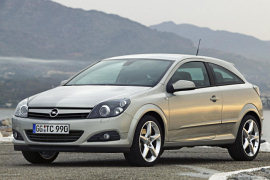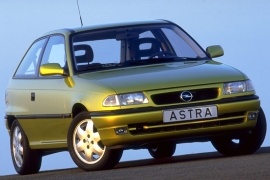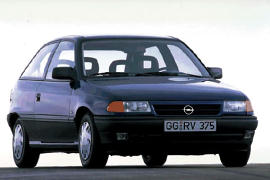OPEL Astra 3 Doors Models/Series Timeline, Specifications & Photos
First production year: 1991
Engines: Diesel, Gasoline
Body style: Hatchback
While the Astra had been around for many years under different body styles, General Motors decided to release a sporty-looking Astra with the aim of a offering a vehicle to appeal to a broader range of customers.
The Astra GTC was one of the greatest success stories ever made by GM. The younger drivers were not very attracted by the oddly-shaped 5-door compact vehicle, thus the new model was exactly what they were looking for.
The Opel Astra GTC was introduced in 2004. While the sporty car had the same underpinnings as its five-door sibling, it shared only a part of the body, transforming it into an overall better-looking vehicle.
The Astra GTC came with a very raked windshield and a sloped back that made the car look like a coupe, rather than a hatchback. The narrowed rear triangular windows and the big tailgate transformed the otherwise dull Astra into an eye-catcher.
The interior was the same as in any other Opel Astra, with a rounded case for the instrument cluster. In the back, there was a good amount of space for two adults. The center tunnel was too tall to fit three passengers in there.
The split-folding rear seatback seat was good for expanding the trunk, and even with the seats up, the trunk was decently sized.
Under the hood, the Astra GTC was offered with a wide choice of diesel and gasoline engines. Its top version was the VXR, which provided 200 hp.
OPEL Astra 3 Doors (GTC) 1.3L CDTI 6AT FWD (90 HP)
OPEL Astra 3 Doors (GTC) 1.3L CDTI 6MT FWD (90 HP)
OPEL Astra 3 Doors (GTC) 1.7L CDTI 5MT FWD (100 HP)
OPEL Astra 3 Doors (GTC) 1.9L CDTI 6AT FWD (120 HP)
OPEL Astra 3 Doors (GTC) 1.9L CDTI 6MT FWD (100 HP)
OPEL Astra 3 Doors (GTC) 1.4L 16V 5AT FWD (90 HP)
OPEL Astra 3 Doors (GTC) 1.4L 16V 5MT FWD (90 HP)
OPEL Astra 3 Doors (GTC) 1.6L 16V 5AT FWD (105 HP)
OPEL Astra 3 Doors (GTC) 1.6L 16V 5MT FWD (105 HP)
OPEL Astra 3 Doors (GTC) 1.6L 16V Turbo 6MT FWD (180 HP)
OPEL Astra 3 Doors (GTC) 1.8 16V 5MT FWD (125 HP)
OPEL Astra 3 Doors (GTC) 1.8L 16V 4AT FWD (125 HP)
OPEL Astra 3 Doors (GTC) 1.8L 16V 4AT FWD (140 HP)
OPEL Astra 3 Doors (GTC) 1.8L 16V 5MT FWD (140 HP)
The second generation of the Opel Astra was released in 1998. Also known as the Opel Astra G, the model was a big step forward compared to the predecessor Astra F.
The Opel Astra G was offered as with a 3-door and a 5-door body style, as well as an exotic Coupe and a Cabriolet, both desighed by Bertone.
With the new model, Opel addressed the drawbacks of the first generation and got a new range of engines, as well as updated interior materials.
Aesthetically, the Astra G 3-doors had a sportier overall look and featured bigger headlights at the sides of a refreshed, modern grille. The overall look was more aerodynamic than before, with the radiator grille integrated in the profiled hood.
Regardless of the car’s color, it still featured black door handles, while other competitors were offering body-colored ones.
The interior was nothing flashy, even if the cabin was fitted with good quality materials. The rather dull interior design was simple and not necessarily inviting, but it did the job.
There was enough room for five adults but limited for three in the back.
The Astra was offered with a choice of diesel and gasoline engines ranged from 75 hp to 147 hp. Most of them were mated to a 5-speed manual, but a 4-speed automatic was available for selected versions.
OPEL Astra 3 doors 1.2L 5MT FWD (65 HP)
OPEL Astra 3 doors 1.4L 16V 5MT FWD (90 HP)
OPEL Astra 3 doors 1.6L 16V 4AT FWD (100 HP)
OPEL Astra 3 doors 1.6L 16V 5MT FWD (100 HP)
OPEL Astra 3 doors 1.6L 4AT FWD (75 HP)
OPEL Astra 3 doors 1.6L 4AT FWD (85 HP)
OPEL Astra 3 doors 1.6L 5MT FWD (75 HP)
OPEL Astra 3 doors 1.6L 5MT FWD (85 HP)
OPEL Astra 3 doors 1.8L 16V 4AT FWD (115 HP)
OPEL Astra 3 doors 1.8L 16V 5MT FWD (115 HP)
OPEL Astra 3 doors 2.0L 16V 4AT FWD (136 HP)
OPEL Astra 3 doors 2.0L 16V 5MT FWD (136 HP)
OPEL Astra 3 doors 2.0L 16V OPC 5MT FWD (160 HP)
Three years after the launch of the new lineup, Opel refreshed the Astra and revealed a sportier-looking three-door version.
While the non-facelifted three-door Astra was almost dull, its refreshed version became more popular, and it wasn't just for the engine lineup but for the slight touches here and there that made it more appealing. Moreover, the customers already knew what they could expect from Opel's compact hatchback.
The 1994 Astra lost the horizontal slats that made it look like an '80s car. It's wide opening with a black mesh-grille at the front sported the chromed Opel badge in the middle. The headlights were flush to it and featured a trim on their inner and lower sides that integrated them better with the front bumper. Its clear turn signals with yellow bulbs also improved the overall front look. Yet, the carmaker placed a bumper with a rounded grille at the bottom, crossed by a horizontal slat that looked bland. The ascending beltline and the slightly enlarged rear fenders gave the car a sportier look. A roof-spoiler adorned the top of the raked-forward tailgate.
Inside, depending on the engine and trim level, Opel provided bolstered bucket seats for the front occupants and a flat bench in the back. The new dashboard included a passenger airbag, improving the car's safety rankings. Opel offered an option for a CD player on the center stack for the top trim levels, while the base version remained without any radio. The rear folding rear bench increased the trunk space from 360 liters (12.7 cu-ft) up to 1,200 liters (42.3 cu-ft).
Since the car had to comply with the Euro2 emission standards, it was available exclusively with fuel injection systems, either single-point or multi-point. The entry-level version received a 1.4-liter, 60 hp unit, but the top-of-the-range variant received a punchy 2.0-liter, 16-valves powerplant that provided 150 ponies.
OPEL Astra 3 Doors 1.4L 5MT FWD (60 HP)
OPEL Astra 3 Doors 1.6L 16V 4AT FWD (100 HP)
OPEL Astra 3 Doors 1.6L 16V 5MT FWD (100 HP)
OPEL Astra 3 Doors 1.6L 4AT FWD FWD (75 HP)
OPEL Astra 3 Doors 1.6L 5MT FWD (75 HP)
OPEL Astra 3 Doors 1.8L 16V 4AT FWD (115 HP)
OPEL Astra 3 Doors 1.8L 16V 5MT FWD (115 HP)
Opel made a bold move at the beginning of the '90s by retiring the Kadett nameplate from its inventory and introducing the Astra moniker in various shapes, including a three-door hatchback.
The German carmaker was still under GM's umbrella when it launched the Astra. With the new name, Opel tried to also attract older people, not only young buyers. After all, retired customers didn't want to buy a vehicle that was named Kadett since it meant young soldier.
But nevertheless, the three-door hatchback was clearly designed for the younger generation. A generation that still dreamed about the sporty feeling of the former Kadett GSI. The carmaker's designers made the Astra with narrow headlights and grille, crossed by a thin slat. Its profile revealed the straight line theme carried over from the Kadett. Its long doors allowed an easier ingress and egress for the rear passengers, while the wide side windows between the B- and C-pillars ensured proper visibility for those inside the cabin. At the back, the raked-forward tailgate followed the same idea from the Kadett hatchback.
Inside, Opel placed its bets on a simple, functional interior centered around the driver. For that, it installed a tilted center stack, with easy-to-reach climate control buttons on the lower side and the stereo cassette above it. In the instrument panel, the carmaker placed the speedometer in the middle, flanked on the sides by the tachometer, and a common area for the fuel and coolant temperature gauges. Opel designed new seats for the Astra, with no bolstering on the sides. A set of sportier seats was on the options list.
Under the hood, Opel installed seven gasoline and two oil burners. The diesel versions were supplied by Isuzu and were offered with or without a turbocharger.
OPEL Astra 3 Doors 1.4i 5MT FWD (60 HP)
OPEL Astra 3 Doors 1.4L iS 4AT FWD (82 HP)
OPEL Astra 3 Doors 1.4L iS 5MT FWD (82 HP)
OPEL Astra 3 Doors 1.6 iS 4AT FWD (100 HP)
OPEL Astra 3 Doors 1.6i 4AT FWD (75 HP)
OPEL Astra 3 Doors 1.6i 5MT FWD (75 HP)
OPEL Astra 3 Doors 1.6L iS 5MT FWD (100 HP)
OPEL Astra 3 Doors 1.8 i 4AT FWD (90 HP)
OPEL Astra 3 Doors 1.8i 16V 5MT FWD (125 HP)
OPEL Astra 3 Doors 1.8i 5MT FWD (90 HP)



